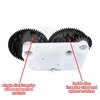Hello,
I've been curious about this encoder I found in garage door openers and how it encodes a position. I gathered a bunch of pictures some I took myself some off the internet.
This is what we have:
-Three through beam photo eyes U1-U2-U3 place
-Two wheels:
- Wheel# 1: Has two discs, outside disc with regularly sized and spaced notches and a second disc with irregular sized and spaced teeth.
-Wheel#2: Has one disc with irregular sized and spaced teeth
The connector pin-out is: GND, +5V, 64, 63, CLK
How does it work, as in how does it determines a position based on those three eyes?
Thanks
I've been curious about this encoder I found in garage door openers and how it encodes a position. I gathered a bunch of pictures some I took myself some off the internet.
This is what we have:
-Three through beam photo eyes U1-U2-U3 place
-Two wheels:
- Wheel# 1: Has two discs, outside disc with regularly sized and spaced notches and a second disc with irregular sized and spaced teeth.
-Wheel#2: Has one disc with irregular sized and spaced teeth
The connector pin-out is: GND, +5V, 64, 63, CLK
How does it work, as in how does it determines a position based on those three eyes?
Thanks









